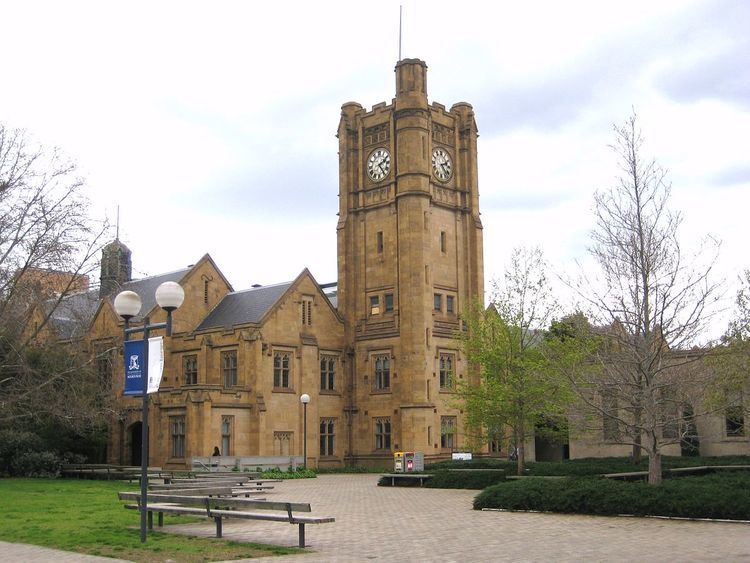Phone +61 3 8344 5892 | ||
 | ||
Profiles | ||
Faculty of Medicine, Dentistry and Health Sciences of the University of Melbourne has the largest amount of post-graduate enrolments in the University of Melbourne and also hosts the most amount of school, department and centres of all University of Melbourne Faculties, consisting of 52 faculty sub-organisations
Contents
About the Faculty
The University of Melbourne’s School of Medicine was founded in 1858 by Anthony Brownless, a graduate of the University of St Andrews School of Medicine. By Federation in 1901, the school had become the Faculty of Medicine.
When the Murray Committee reported in 1956 on the inadequacies of the nation's tertiary education sector, the mood to change medical education accelerated. The University was central to the revolution to medicalise society through the expansion of medical services. During the decades to follow, the University was the only tertiary institution to mentor the development of a number of medical institutions in South-East Asia and here in Victoria, the Monash Medical School.
In 1989 the University's Faculty of Dental Science amalgamated with Medicine to become the Faculty of Medicine and Dentistry and later expanded again to include Physiotherapy, Psychology and Nursing. The University established Australia's first School of Population and Global Health in 2001 and then the School of Rural Health in 2002. As of 2016, the faculty also includes the School of Social Work (having moved from the University of Melbourne Faculty of Arts) as well as the Nossal Institute for Global Health.
Adapted from Humanity's Mirror: 150 Years of Anatomy in Melbourne. as well as the Faculty's "Our History" web page.
Faculty structure
The Faculty of Medicine, Dentistry and Health Sciences encompasses several Schools directly beneath it. Within each School, there are also several Departments, Research Centres, and Institutes that are contained. Each Department, Research Centre, and Institute can also contain several Research Unit sub-organisations which focus on specific research areas (for example Academic Unit for Psychiatry of Old Age or Public Health Insight). An overview of the Faculty Schools and structure are as follows:
Associated Research institutes
Partner Centres
Major projects
Through extensive partnerships, the Faculty has been involved in a range of developments, including the Victorian Comprehensive Cancer Centre, the Western Centre for Health Research and Education, the Peter Doherty Institute and the Melbourne Brain Centre.
Medicine, Dentistry and Health Sciences Research
The University of Melbourne was ranked in the top 20 in the world in clinical, pre-clinical and health subjects by the 2015 QS World University Rankings. The Faculty is highly active with over 1400 researchers in eight broad research domains encompassing the breadth of medicine, dentistry and the health sciences. The Faculty has also developed a tool to "Find a researcher" in by speciality in their relevant field.
As of 2016, some examples of research outcomes from the University of Melbourne School of Medicine, Dentistry, and Health Sciences include the Stentrode a collaboration between the University of Melbourne, the Royal Melbourne Hospital and the Florey Institute of Neuroscience and Mental Health, treatment research for pre-eclampsia, and prosthetic body parts that can simulate touch sensations to amputees.
Criticisms
"The Bradley report into Higher Education stated that participation by students from low socio-economic backgrounds in higher education in Australia needs to be increased. The Federal Government and Universities have been working hard to achieve this aim, which AMSA strongly supports. So for one of Australia's leading Universities to make an active decision to disadvantage students from low socio-economic backgrounds is very disappointing and will undermine much the good work being done around the nation,” said Ross Roberts-Thomson, AMSA President. This alteration from labelling the course from "undergraduate" to "post-graduate" was seen as a way of avoiding the Australian Governments ban on full fee paying places for Undergraduate degrees, and as increasing potential barriers for applicants from low socio-economic background from enrolling.
Medicine, Dentistry and Health Sciences Course example of Fee Structure
The Faculty of Medicine, Dentistry and Health Sciences has various fees associated with their courses that are variant depending on factors such as whether the student enrolling is Domestic or International, what type of degree they are studying, whether they are enrolling in a course that accepts Australian Government Commonwealth Supported Places or if the enrolling student is paying full fees upfront, and also what level of education the degree pertains to (Masters, Doctorate, Bachelor etc.)
As an example, the table below is taken from the University of Melbourne Fee tables and calculations website and lists student contributions for 1 Equivalent Full-Time Student Load in 2017.
The University offers a method of calculating student contributions on the University of Melbourne Fee Calculator Website which lists the EFTSL amount per course along with course codes.
Present and Past Faculty Deans
Below is a list of the Faculty deans from 1876 to the present:
Student associations
The Faculty provides varying levels of administrative support to the following clubs and societies at the University of Melbourne:
